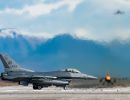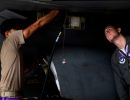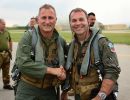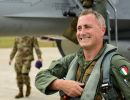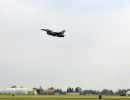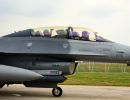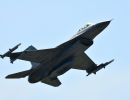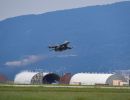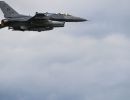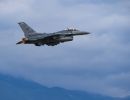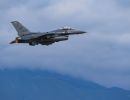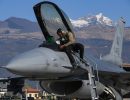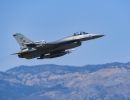
David Sarvai
Operation DENY FLIGHT
Deny Flight enforced the no-fly zone, provided close air support to UN troops, and conducted approved air strikes under a "dual-key" command arrangement with the UN. NATO Airborne Early Warning and Control (AWACS) aircraft began monitoring operations in October 1992, in support of UN Security Council Resolution 781, which established a no-fly zone over Bosnia-Herzegovina. Data on possible violations of the no-fly zone has been passed to the appropriate UN authorities on a regular basis.
On 31 March 1993, the UN Security Council passed Resolution 816 authorising enforcement of the no-fly zone over Bosnia-Herzegovina and extending the ban to cover flights by all fixed-wing and rotary-wing aircraft except those authorised by UNPROFOR. In the event of further violations, it authorised UN member states to take all necessary measures to ensure compliance. An enforcement operation, called "Deny Flight", began on 12 April 1993. It initially involved some 50 fighter and reconnaissance aircraft (later increased to over 100) from various Alliance nations, flying from airbases in Italy and from aircraft carriers in the Adriatic. By the end of December 1994, over 47,000 sorties had been flown by fighter and supporting aircraft.
On 28 February 1994, four warplanes violating the no-fly zone over Bosnia-Herzegovina were shot down by NATO aircraft. This was the first military engagement ever undertaken by the Alliance.
In June 1993, NATO Foreign Ministers decided to offer protective air power for the United Nations Protection Force (UNPROFOR) in the performance of its overall mandate. In July, NATO aircraft began flying training missions for providing such Close Air Support (CAS). On 10 and 11 April 1994, following a request from the UN Force Command, NATO aircraft provided Close Air Support to protect UN personnel in Gorazde, a UN-designated safe area in Bosnia-Herzegovina.
At the January 1994 Brussels Summit, Alliance leaders reaffirmed their readiness, under the authority of the UN Security Council and in accordance with the decisions of the North Atlantic Council of 2 and 9 August 1993, to carry out air strikes in order to prevent the strangulation of Sarajevo, the safe areas and other threatened areas in Bosnia-Herzegovina. On 9 February 1994, the North Atlantic Council condemned the continuing siege of Sarajevo and decided to carry out air strikes against any further use of artillery and mortars in and around Sarajevo. The heavy weapons of any of the parties remaining in an area within 20 kilometres of the centre of the city after 20 February, would be subject to NATO air strikes conducted in close coordination with UNPROFOR.
On 21 February, following the expiry of the above deadline, NATO's Secretary General announced that the objectives set on 9 February were being met and that UN and NATO officials had recommended that air power should not be used at that stage.
In response to a written request by the UN Secretary General, the North Atlantic Council took further decisions on 22 April to support the UN in its efforts to end the siege of Gorazde and to protect other safe areas. These decisions were made public in two separate statements, issued by the Council.(1) Unless Bosnian Serb attacks against the safe areas of Gorazde ceased immediately, and Bosnian Serb forces withdrew three kilometres from the centre of the city by 00:01 GMT on 24 April, and unless humanitarian relief convoys and medical assistance teams were allowed free access by the same date, the Council announced that the Commander in Chief of Allied Forces Southern Europe was authorised to conduct air strikes against Bosnian Serb heavy weapons and other military targets within a 20-kilometre radius of Gorazde, in accordance with the procedural arrangements worked out between NATO and UNPROFOR following the Council's decisions of 2 and 9 August 1993.
It further declared that after 00:01 GMT on 27 April, specified military assets and installations would be subject to air strikes if any Bosnian Serb heavy weapons remained within a 20-kilometre exclusion zone around the centre of Gorazde. Regarding other UN-designated safe areas (Bihac, Srebrenica, Tuzla, and Zepa), the Council authorised air strikes if these areas were attacked by heavy weapons from any range. These other safe areas could also become exclusion zones if, in the common judgement of the NATO and UN Military Commanders, there was a concentration or movement of heavy weapons within a radius of 20 kilometres around them. These measures would be carried out using agreed coordination procedures with UNPROFOR (the so-called "dual key" system).
On 5 August, NATO aircraft attacked a target within the Sarajevo Exclusion Zone at the request of UNPROFOR. The air strikes were ordered following agreement between NATO and UNPROFOR, after weapons were seized by Bosnian Serbs from a weapons collection site near Sarajevo. On 22 September, following a Bosnian Serb attack on an UNPROFOR vehicle near Sarajevo, NATO aircraft carried out an air strike against a Bosnian Serb tank, at the request of UNPROFOR.
On 28 October 1994, following meetings in New York between UN and NATO officials, a joint statement was issued on understandings which had been reached concerning the use of NATO air power in Bosnia-Herzegovina in support of the relevant UN resolutions.
On 21 November 1994, NATO aircraft attacked the Udbina airfield in Serb-held Croatia. The air strike, conducted at the request of and in close coordination with UNPROFOR, was in response to recent attacks launched from that airfield against targets in the Bihac area of Bosnia-Herzegovina. It was carried out under the authority of the North Atlantic Council and United Nations Security Council Resolution 958.
Attacks on two NATO aircraft were launched from a surface-to-air missile site south of Otoka, in north-west Bosnia-Herzegovina. Following reconnaissance missions which demonstrated that the site posed a continued threat to aircraft participating in "Deny Flight", and in accordance with self-defence measures previously announced, an air strike was conducted against this site by NATO aircraft, in close coordination with UNPROFOR, on 23 November 1994.
On 24 November 1994, the North Atlantic Council also decided that NATO air power could be used, under the provisions of United Nations Security Council Resolution 958, against aircraft flying in Croatian air space which have engaged in attacks on or which threaten UN safe areas, subject to making arrangements with the Croatian authorities.
Capt. Scott F. O'Grady's F-16 was shot down by a surface-to-air missile south of the Bosnian city of Banja Luka 02 June 1995. He evaded capture by Bosnian Serb forces for six days before his rescue June 8 by a Marine Corps search and rescue team with multinational support. The mission O’Grady flew brought the eyes of the nation upon him at a time of national mourning over the Oklahoma City bombing. America needed a hero, and Scott O’Grady was that man. For six days the nation held it’s breath while efforts were conducted to ascertain his whereabouts and condition, and to arrange for his rescue. On the sixth day in a daring operation, the Army, Navy, Air Force and Marines combined their efforts and successfully rescued him -- twenty-five pounds lighter, dehydrated and physically reduced by severe hypothermia. The NATO multinational effort included support from about 40 aircraft including F-16C, F-15E, EF-111, A-10, KC-135R, HC-130 and MH-53J.
During Deny Flight operations, two Air Force NCOs received Purple Hearts for injuries while searching for two downed French pilots. Crews flying Air Force AC-130H gunships fired on targets enforcing UN restrictions in Bosnia. They also transported supplies and personnel into the country.
NATO's Deny Flight operation, enforcing the no-fly zone over Bosnia, terminated on December 20, 1995, when implementation force (IFOR) assumed responsibility for airspace over Bosnia. Operation Deny Flight transitioned to Decisive Edge in support of the IFOR Operation Joint Endeavor.
Operation DELIBERATE FORCE
After the fall of the eastern Bosnian "safe areas," in July 1995, the international community agreed to steps to extend NATO air power. NATO extended its threat of air strikes against Bosnian Serbs if they attacked any of the remaining "safe areas" in Bosnia. "Safe areas" include Gorazde, Tuzla, Bihac and Sarajevo. Serb forces wasted no time testing the world's will and launched attacks against the "safe areas" of Zepa, Bihac and Sarajevo. To complicate things even further, Croatian forces entered the fighting in early August.
NATO launched a sustained air strike campaign, Operation Deliberate Force, beginning on August 30, 1995, against Bosnian Serb military targets in response to a Bosnian Serb mortar attack on civilians in Sarajevo.
Air strikes were conducted on eleven days during the period 29 August through 14 September 1995. Of the total of 3515 sorties flown, 2470 were penetrating sorties, which included attacks on 48 target complexes [consisting of 338 individual targets within target complexes]. Of the 1026 bombs dropped, precision munitions numbered 708 and non-precision munitions 318.
On 30 August 1995 a French Mirage 2000K was shot down by a man-portable surface-to-air missile, 20 NM SE of Pale. Efforts to locate and rescue the downed French aircrew continued until 28 Sep 95 when French authorities informed CINCSOUTH of their conviction that the French aircrew had been "recovered alive and taken into custody by the Bosnian Serbs."
In the view of the US Defense Department, Operation DELIBERATE FORCE proved that airpower can have a decisive role when serving achievable, clear policy objectives. Airpower's efforts in helping to lift the siege of Sarejevo saved lives and helped pave the way for a negotiated settlement. Deliberate Force was the crucial step in bringing the warring parties to the negotiating table at Dayton, leading to the peace agreement.
Operation ALLIED FORCE
The Kosovo crisis began in early 1998 when large-scale fighting broke out, resulting in the displacement of some 300,000 people. A ceasefire was agreed in October 1998 which enabled refugees to find shelter, averting an impending humanitarian crisis over the winter. A Verification Mission was deployed under the auspices of the Organization for Security and Cooperation in Europe (OSCE). However, violence continued and the situation worsened significantly in January 1999. A peace conference, held in Paris, broke up on 19 March with the refusal of the Yugoslav delegation to accept a peaceful settlement.
Operation Allied Force was a NATO contingency response aiming at ensuring full compliance with UN Security Council Resolution 1199 (Sept. 23rd 1998). Operation Noble Anvil was the American component of this NATO action to promote regional stability, cooperation and security, in support of the international community. At 1900 hours GMT on 24 March 1999, NATO forces began air operations over the Federal Republic of Yugoslavia. These air strikes against Serbian military targets in the Former Yugoslavia sought to:
Ensure a verifiable stop to all military action and the immediate ending of violence and repression in Kosovo; Withdrawal from Kosovo of Serbian military, police and para-military forces; Agreement to the stationing in Kosovo of an international military presence; Agreement to the unconditional and safe return of all refugees and displaced persons, and unhindered access to them by humanitarian aid organizations; and Provide credible assurance of Serbian willingness to work on the basis of the Rambouillet Accords in the establishment of a political framework agreement for Kosovo in conformity with international law and the Charter of the United Nations.
NATO was prepared to suspend its air strikes once Belgrade unequivocally accepted the above mentioned conditions and demonstrably began to withdraw its forces from Kosovo according to a precise and rapid timetable. This would follow the passage of a United Nations Security Council resolution requiring the withdrawal of Serb forces and the demilitarization of Kosovo and encompassing the deployment of an international military force to safeguard the swift return of all refugees and displaced persons as well as the establishment of an international provisional administration of Kosovo.
The multinational force was tasked by NATO to bring a swift end to hostilities committed by the Federal Republic of Yugoslavia against ethnic Albanians in the southern province of Kosovo. The military objective of Operation Allied Force was to degrade and damage the military and security structure that Yugoslav President President Milosevic has used to depopulate and destroy the Albanian majority in Kosovo. The Supreme Allied Commander Europe (SACEUR) delegated authority for the implementation of Operation Allied Force to the Commander in Chief of Allied Forces Southern Europe (CINCSOUTH), whose headquarters is in Naples, Italy. CINCSOUTH delegated control of the operation to the Commander, Allied Air Forces Southern Europe (COMAIRSOUTH), also based in Naples. Operational conduct of day-to-day missions was delegated to the Commander 5th Allied Tactical Air Force, at Vicenza, Italy.
The Yugoslavs apparently thought that they could wipe out the Kosovar Liberation Army in five to seven days as part of Operation Horseshoe. They thought thought once they did that, they could negotiate an arrangement for peace. The Serbian leadership apparently also assumed that NATO would never launch airstrikes, and that once the airstrikes were launched they would be pinpricks lasting a few days. And they assumed that NATO would not remain unified long enough to carry out significant air attacks, which would quickly end due to political divisions within NATO.
Operation plan OPLAN 10601 "Allied Force" covered altogether five phases, which went from the transfer over a possible application outside of and within the air space of the Federal Republic of Yugoslavia up to redeployment. The Application instruction (ACTORD) was effective from 13 October 1998, with simultaneous approval and preparatory exercises. The decision by NATO of 27 October 1998 was to maintain the ACTORD with execution dependent on further a NATO council decision. Constrained by the directive that collateral damage was to be avoided as far as possible, the concept of operations envisioned targeting based on a phase-wise gradual, situation-adjusted application of NATO air forces, depending upon political and military developments. Operation Allied Force implemented, when ordered by the North Atlantic Council, phased operations which differ according to the attack targets and their geographical location.
Phase Zero - During Phase 0, released on 20 January 1999 as political signal, air forces of NATO were shifted for the accommodation of practice flight operation to their operational airfields.
Phase One -- Conduct limited air operations, such as air strikes against designated militarily significant targets. Phase 1 began on 24 March 1999 with attacks on the integrated air-defense system (e.g. weapon systems, radar facilities, control devices, airfield/aircraft) in the entire Federal Republic of Yugoslavia.
Phase Two -- Since the authorization of this phase on 27 March 1999 attacks extended to the security forces infrastructure military in Kosovo and reinforcement forces (e.g. headquarters, telecommunication installations, material and ammunition depot, systems for production and storage of fuel, barracks). The authorization of this phase took place with the unanimous resolution of the NATO allies.
Phase Three - The focus of this phase, which was not authorized, was the expansion of the air operations against a broad range of particularly important targets of military importance north of the 44th parallel in the entire Federal Republic of Yugoslavia. [24 Apr. 1999 NATO Press Conference] By a month into the air campaign it became apparent to NATO that a constrained, phased approach was not effective. At the insistence of US leaders, NATO widened the air campaign to produce the strategic effects in Serbia proper. At the April NATO Summit SACEUR was given the flexibility to strike at additional targets, within the existing authority of phase 1 and phase 2 of the operation that were necessary to keep the pressure up, both on the tactical side in Kosovo and on the strategic side elsewhere in Yugoslavia.
Phase Four -- [support of stabilization operations?]
Phase Five -- [redeployment operations?]
The Phase One "Limited Air Response" provided a fast available, temporally limited and supported with small strength feasible air operations against military targets in the Federal Republic of Yugoslavia - exclusive to the use of precision standoff weapons. Additional operations outside of the Federal Republic of Yugoslavia were provided for observation and for the air defense of the air space of NATO nations and Bosnia-Herzegovina as well as to the protection of SFOR. The selection of target categories with the target of the minimization of collateral damage with at the same time high political and military significance. Operation execution was required within 48 hours after decision of the NATO advice possible. This Operations Concept was approved on 21 August 1998, with application instruction ACTORD from 13 October 1998; the decision NATO advice of 27 Octover 1998 for maintenance ACTORD with execution dependent on further NATO council decision.
The early goal of Phase One of the campaign was to attempt to force Yugoslavia to the bargaining table. Some countries in NATO argued that it might be possible to do that with a few days or a week of attacks, without demolishing the whole country. Some of the NATO partners were initially prepared to wage only a phased air operation to show NATO's resolve in the hope of achieving an early settlement. The campaign did not begin the way that America normally would apply air power -- massively, striking at strategic centers of gravity that support Milosevic and his oppressive regime. The phased concept of operations of Operation Allied Force did not apply principles of military operations such as surprise and the use of overwhelming force, and this cost time, effort and potentially additional casualties, the net result being that the campaign was undoubtedly prolonged. NATO did not succeed in this initial attempt to coerce Milosevic through airstrikes to accept its demands, nor did it succeed in preventing the FRY pursuing a campaign of ethnic separation.
Initial air operations started at an altitude that was estimated to be appropriate for the air defense threat that was expected, which allowed attacks against fixed targets with guided munitions in Kosovo and around Belgrade. Flying at or above 15,000 feet, attack aircraft were flying only at night and were instructed not to make multiple passes or other maneuvers that would entail unnecessary risks. NATO gained air superiority over Kosovo and the rest of Yugoslavia by degrading Milosevic's integrated air defence system. After allied planes mistakenly bombed two refugee convoys on the same day near the Kosovo town of Djakovica, new tactics were implemented with pilots flying lower to identify targets better. The net result was increased risk to allied pilots. Three NATO fighter-bombers were hit by ground fire in early May, and an American F-16 crashed with engine failure over Serbia as a result of Yugoslav anti-aircraft fire.
As Yugoslavia demonstrated that it was completely unmoved and intransigent, the pressure and the tempo of the attacks grew, with the decision at the NATO Summit here on 23 April 1999 to expand the campaign. As the campaign continued, the target list expanded into so-called sustainment targets -- petroleum, lines of communication, electrical grids, and command and control targets.
Air operations did not attack some strategic targets because of anxiety among NATO's 19 governments that further accidental civilian casualties could erode public support for the operation. On 07 May 1999 NATO bombed the Chinese Embassy in Belgrade. The planned target was the Federal Directorate for Supply and Procurement in Belgrade but the wrong building was attacked. Following NATO's mistaken bombing of the Chinese embassy, the alliance stopped hitting targets in the city for nearly two weeks while NATO authorities sought to ensure that another such mistake would not occur.
By mid-May NATO pilots had grown increasingly familiar with Kosovo's terrain and with the tactics of the Serbian Armed Forces on the ground. Pilots increasingly knew where Serbian forces were concentrated, which explained the change in the tactics of Serbian forces. They were operating in smaller and smaller units to make them harder to detect from the air. The downside for the Serbian forces is that this made them increasingly vulnerable to KLA ambushes, and it also made Serb forces less mobile to the benefit of those Kosovars still living within Kosovo.
Responsive or "Flex" targets were targets in the fielded forces, and normally not targets that would be a static target like a bridge or a petroleum area or a building. Such targets move around, and would be located by various means, such as a pilot report or JSTARS. NATO had aircraft in the area that can respond rapidly to attack such "Flex" targets. Quick response options for targets that may pop up via different means included aircraft holding on a tanker outside the area waiting for a target to occur, aircraft on the ground waiting on alert, or aircraft diverted from another engagement zone to a target of opportunity.
During the first two months of air operations the majority of days the weather was unfavorable or marginal. Persistent low cloud cover over Kosovo and the rest of Yugoslavia forced the cancellation of many planned strikes. NATO had the capability to operate through solid cloud cover, however for a variety of reasons there were restrictions on operations in bad weather. The single biggest reason was the commitment to ensuring strikes against only military and military-related targets. Flying below the clouds is more dangerous from a technical standpoint, putting NATO air crews down into the range of tactical surface to air missiles, anti-aircraft artillery and small arms fire. It also highlights aircraft against the clouds, making them easier to see and target from the ground. Kosovo is a very mountainous area, and with the peaks of mountains frequently enveloped by the clouds, air crews were careful about avoiding terrain. The weather also provided some cover for the Serbian military to continue their attacks, and they took advantage of these times to conduct ground and air operations.
At the beginning of the operation, the weather was so poor that NATO could operate against fielded forces only about 15% of the time. Since those early days NATO adapted its tactics to take maximum advantage of its comprehensive array of intelligence gathering capabilities. By early May NATO was able to collect and distribute information efficiently so that air crews were able to react quickly to targets of opportunity. NATO also adjusted flying patterns to ensure a continuous presence of combat air power that is able to operate in the directed attacks against Serbian ground forces. NATO had planes circling, awaiting the call to strike from other aircraft flying forward air control spotter missions.
The fundamental factor in the conclusion of ALLIED FORCE was NATO's unity and resolve. NATO acted in a way that was tough, progressively tougher throughout the campaign. It failed to be deflected from its goals. This lesson was very clear to Milosevic, who had hoped he could outwit NATO. Secondly, both the precision and the persistence of the air campaign were fundamental factors in convincing Milosevic that it was time to end the fight. The air campaign, which started slowly but gathered momentum as it went on, became systematically damaging to his entire military infrastructure, not just the forces in the field in Kosovo, but throughout the entire country. The pounding his forces took during the last week had to have a huge impact on his determination to continue the fight. It had a big impact on the morale of the forces. Desertions were increasing, and there were increasing reports of lack of food, lack of fuel, lack of equipment, lack of will, lack of morale, and increasing dismay with the leadership not only of the forces but of the country, and an increasing feeling that they just saw no way out. And they realized, because of NATO's persistence, the situation was just going to get steadily worse.
On 3 June, President Slobodan Milosevic finally accepted peace terms presented by EU envoy President Martti Ahtisaari and Russian envoy Viktor Chernomyrdin. With the authorization of the United Nations on 10 June 1999, NATO forces deployed into Kosovo.
Operation DESERT SHIELD
In 1990, fellow Arab Gulf states refused to endorse Iraqi leader Saddam Hussein's plan to cut production and raise the price of oil, leaving him frustrated and paranoid. Iraq had incurred a mountain of debt during its war with Iran that had lasted for most of the previous decade, and the Iraqi President felt that his Arab brothers were conspiring against him by refusing to raise oil prices. Therefore, after weeks of massing troops along the Iraq-Kuwait border and accusing Kuwait of various crimes, Hussein sent seven divisions of the Iraqi Army into Kuwait in the early morning hours of 2 August 1990. The invasion force of 120,000 troops and 2,000 tanks quickly overwhelmed Iraq's neighbor to the south, allowing Hussein to declare, in less than a week, that Kuwait was his nation's nineteenth province. The United Nations responded quickly, passing a series of resolutions that condemned the invasion, called for an immediate withdrawal of Iraqi troops from Kuwait, imposed a financial and trade embargo on Iraq, and declared the annexation void.
Regarding Iraq's actions as a threat to a vital interest of the US, namely the oil production capability of the Persian Gulf region, President George Bush ordered warplanes and ground forces to Saudi Arabia after obtaining King Fahd's approval. Iraqi troops had begun to mass along the Saudi border, breaching it at some points, and indicating the possibility that Hussein's forces would continue south into Saudi Arabia's oil fields. Operation DESERT SHIELD, the US military deployment to first defend Saudi Arabia grew rapidly to become the largest American deployment since the Southeast Asia Conflict. The Gulf region was within US Central Command's (CENTCOM) area of responsibility. Eventually, 30 nations joined the military coalition arrayed against Iraq, with a further 18 countries supplying economic, humanitarian, or other type of assistance.
Carriers in the Gulf of Oman and the Red Sea responded, US Air Force interceptors deployed from bases in the United States, and airlift transports carried US Army airborne troopers to Saudi Arabia. Navy prepositioning ships rushed equipment and supplies for an entire marine brigade from Diego Garcia in the Indian Ocean to the gulf. During the next six months the United States and its allies built up a powerful force in the Arabian peninsula. The navy also began maritime intercept operations in support of a US-led blockade and United Nations sanctions against Iraq.
On 17 January 1991, when it became clear that Saddam would not withdraw, Desert Shield became Desert Storm.
Operation DESERT STORM
Saddam Hussein's rejection of diplomatic efforts to solve the crisis led to the decision to restore Kuwait's sovereignty by military force. The ensuing air war and the effects of the economic embargo decimated Iraq's military infrastructure, severed communication and supply lines, smashed weapons arsenals, and destroyed morale. Overall, the coalition air campaign accumulated a total of 109,876 sorties over the 43-day war, an average of 2,555 sorties per day. Of these, over 27,000 targeted Scuds, airfields, air defenses, electrical power, biological and chemical weapons, headquarters, intelligence assets, communications, the Iraqi army, and oil refining.
The Gulf War was not an exercise in massive bombing unparalleled in previous air war history; neither the sortie rates nor the bomb tonnage statistics made it so. The Air Force's tonnage expenditure in the Gulf War was only 11% of that expended against Japan (537,000 tons), less than 4% of that expended against Nazi Germany (1,613,000 tons), and less than one percent of the tonnage which the Air Force dropped in Southeast Asia. In measures of tonnage dropped per month, the Gulf air war ranked significantly below Vietnam, and was only 85% of that in the Second World War. Yet it was more decisive overall in what it achieved than any of these previous wars.
During DESERT STORM, 10th ADA Brigade from Germany commanded a task force which included Dutch, US and Israeli Patriot batteries in defense of Tel Aviv and Haifa. ADA lieutenants were debriefed at the Israeli Defense Forces "Pentagon" after each Scud attack. Within twenty nine hours of "wheels up" for the first aircraft, the TF 4-43 ADA was operational in Israel in two locations.
TF 4-7 ADA (Patriot) deployed from Germany to Incirlik Turkey where they provided ADA protection to critical assets poised at Iraq's "back door".
TF 2-43 ADA (Patriot) deployed from Germany & was attached to 11th ADA Brigade, providing Scud defense of King Khalid Military City in Saudi Arabia.
TF 8-43 ADA (Patriot) deployed from Germany and provided general support to VII Corps.
After a 38-day air campaign, the DESERT SABRE ground offensive began with allied forces sweeping through Iraqi defenses. The Iraqi army was crushed after a mere 100 hours. Iraqi troops--tired, hungry and war-weary from six months of economic blockade and more than a month of relentless allied bombing--surrendered by the thousands.
Desert Storm is also known as the Mother of all Battles (Umm Al-Ma'arik -- the Arabic "mother of" is a figure of speech for "major" or "best"). Saddam Hussein's biography notes that he: "Led his country in confrontation the aggression launched by 33 countries led by US. which waged war against Iraq, the Iraqis' confrontation of which is called by Arabs and Iraqis as the Battle of Battles (Um Al-Ma'arik), where Iraq stood fast against the invasion, maintaining its sovereignty and political system."
Operation DETERMINED FALCON
Approximately 80 aircraft from 13 countries participated in Operation Determined Falcon, a show of force brought about by bloodshed in Kosovo, the separatist Serbian province wracked by violence. Meant to promote peace and stability in the region, the multinational operation which started on 15 June 1998 called for NATO fighter jets to patrol Yugoslavian borders with Albania and Macedonia. Reconnaissance, airborne warning and tanker aircraft, along with helicopters, participated in the airpower demonstration over Albania and the Former Yugoslav Republic of Macedonia.
In Operation Determined Falcon, 85 aircraft from 13 NATO countries took off from 15 bases across Europe and from carriers in the Adriatic Sea. Support planes and refueling tankers backed up these aircraft. 28 of the aircraft left Aviano Air Base in Italy by 7 a.m. heading first to Macedonia and then to Albania. Jets flew across both countries and edged within 10 miles of the Yugoslav border. The exercise ended at noon. "This is an exercise intended to demonstrate the alliance's commitment to peace and stability in the region and [our] ability to project power into the region," said Lt. Gen. Michael Short, commander of NATO air forces in southern Europe.
Key breaks between NATO and Russia became obvious with regard to the air simulation. Russian defense minister, Marshal Igor Sergeyev, said he had not been informed in advance that NATO would begin its air exercises on Monday. Sergeyev publicly rebuked General Henry H. Shelton, chairman of the U.S. Joint Chiefs of Staff, at a meeting in Moscow. With reporters and cameras present, the Russian said he had met with Shelton and Defense Secretary William S. Cohen at NATO headquarters in Brussels on Friday. "We discussed the Kosovo problem in detail. We all agreed that first of all it was necessary to resolve it with political measures. And as soon as I get back to Moscow I find out the exercises have begun. This was unexpected for me. As a soldier, I am used to valuing honesty in people. I can't understand why they treated me in this way."
In the aftermath of the air show, President Milosevic headed to Moscow for consultations with Russian President Yeltsin, and US and NATO leaders discussed future plans. Defense Secretary William Cohen on Tuesday played down the prospect of a quick NATO military response if Yugoslavia refused to stop its crackdown in Kosovo, saying this would require lengthy consultation. " 'No such decision has been made on the use of any military force," Cohen told a news conference during a visit to Warsaw. "A good deal more deliberation would have to take place within NATO. There is of course some disagreement as to what the legal foundation would be for the exercise of military options if they become necessary and all of us have to consult with our parliaments and congresses."
Disagreements within the U.S. military were also reported. The Washington Post reported, "As top U.S. national security officials threaten the use of military power to resolve the crisis in Kosovo, U.S. military planners have expressed deep misgivings about the amount of force it would take to protect NATO aircraft and force the Yugoslav government to change course in the province." It further stated that "Pentagon officials say they have made it clear to President Clinton's foreign policy advisers that to protect NATO aircraft, any air strike would have to be preceded by an all-out bombardment of Yugoslavia's 60 surface-to-air missile sites and its 241 combat aircraft, a preparatory action that one defense official described as a smaller-scale version of the Desert Storm air campaign."
On Tuesday, the meeting between President Milosevic and President Yeltsin took place. President Milosevic agreed to meet many -- but not all -- of the demands set by NATO and the Contact Group. But Milosevic did not accept the key demand for an immediate withdrawal of Serbian security forces in the southern Serbian province. The joint declaration issued said Belgrade would resolve problems in Kosovo by political means, continue negotiations, carry out no repressive actions against civilians, allow freedom of movement and set no limits on foreign diplomats and international organizations accredited to Yugoslavia. It promised free access for humanitarian organizations, the right for all refugees and displaced persons to return home, state help in rebuilding destroyed homes and added: "In accordance with the stopping of terrorist activities, the security forces will cut back their presence outside bases."
Russian Foreign Minister Yevgeny Primakov hailed Milosevic's concessions as a breakthrough after months of fighting. "'We consider this now opens a real possibility to regulate the situation and the ball is now to a large extent in the Kosovo Albanians' court," Primakov told a news conference. The Russians continued to hold to a separate path than NATO's during this week. Itar-Tass news agency in Russia reported that Defense Ministry's Colonel-General Leonid Ivashov as saying that NATO action in Kosovo without U.N. support "would lead to the start of a new Cold War." His comments marked a new stage in Russia's battle of words with NATO.
The view held by President Milosevic of the offensive in Kosovo seemed radically different than that reported in the press and than that seemingly obvious to all observers. In a defiant press conference in an ornate Russian Foreign Ministry mansion in Moscow, Milosevic denied that Serbian forces had ever harmed ethnic Albanians. "There was no kind of ethnic cleansing," Milosevic said. "In the latest actions it was declared by the security forces there were no civilian victims at all."
While General Wesley Clark said that the success of the exercises demonstrated NATO's "capability to rapidly project power if required," the Serbs continued their offensive in Kosovo. Serb forces matched NATO's show of force Monday with the real thing, attacking four villages in western Kosovo with grenades, helicopter gunships and heavy shelling, ethnic Albanians claimed. The fighting was a sign to many ethnic Albanians that the NATO exercises had angered the Serbs, and that direct intervention was needed to halt the bloodshed.
Yeltsin expressed Russian opposition to a military intervention against Belgrade. The United States declared that a possible NATO intervention would not need UN authorization, a view not supported by Paris and Bonn. NATO could decide to act without a mandate of the UN Security Council, which would risk its fragile relationship with Russia, the Serbs' patron of long standing. France refused to go along with the military action unless the UN Security Council approved, and Russia promised to veto any resolution that authorized it.
Operation NORTHERN WATCH
Operation Northern Watch is a US European Command Combined Task Force (CTF) charged with enforcing the United Nations mandated no-fly zone above the 36th parallel in Iraq. The mission also entails monitoring Iraqi compliance with UN Security Council directives. The coalition partners of the United States, United Kingdom, and Turkey provide approximately 45 aircraft and more than 1,400 personnel to support Operation Northern Watch. The joint U.S. force of some 1,100 US personnel, includes sailors, soldiers and airmen from the Air Force, Army, Navy and Marine Corps. The original mandate from the Turkish government allowed the operation to continue for 6 months. Turkey subsequently approved two 6-month extensions, but indicated that it would not become a permanent mission.
Though the majority of the U.S. contingent is made up of Air and Space Expeditionary Forces on three month tours, Operation Northern Watch is a Combined Task Force which includes active duty Army, Navy, Marine and Air Force members as well as National Guard and reserve troops on 14 to 180 day tours. It has a 700 percent annual turn-over rate in personnel, with more than 9,000 cycle through Northern Watch each year.
The task force includes more than 50 U.K. and U.S. aircraft assigned. Coalition fighters, tankers, intelligence, surveillance and reconnaissance assets work as a team to enforce the no-fly zone. Missions require a mix of aircraft and on any given day could include: EA-6B Prowler, E-3 Sentry AWACS, F-15C, F-15E, F-16CJ, F-16CG, HH-60, HC-130, KC-135 Stratotanker, UH-60 Blackhawk, EP-3, C-12, British GR-3 Jaguar, Nimrod and VC-10 Tankers.
U.K. and U.S. aircraft fly patrol missions over Iraq an average of 18 days each month. By the end of November 2002, coalition forces have flown 106 days in the Northern No-Fly Zone. In 2001, they flew 146 days over northern Iraq and in 2000, they flew 164 days. Nearly every mission, they are under fire and threatened by elements of the Iraqi integrated air defense system. Anti-aircraft-artillery fire is the most common threat and is usually seen firing from two to five different locations.
Operation Northern Watch is the successor to Operation Provide Comfort, which officially ended in December, 1996. With the closing of the Military Coordination Center in 1996 the Secretary of Defense approved a modification of the mission in Northern Iraq. Since 1991, Operation PROVIDE COMFORT had provided humanitarian assistance to the Kurds and enforcement of the northern no-fly zone.
The enforcement of the No Fly Zone continued for almost two years witnessing a change for the worse in Iraq’s compliance with United Nation’s (UN) resolutions. Specifically Security Resolution 687, requiring Iraq to dispose of its weapons of mass destruction ballistic missiles with a range over 150 kilometers, and related production facilities and equipment. Since ONW started, Iraq grossly interfered with any progress made by UN arms inspectors on three separate occasions.
The first of these occurred on 13 November 1997 when Iraq expelled U.S. arms inspectors only to see them returned one week later.
On 13 January 1998, Iraq banned UN arms inspectors led by an American to continue their work forcing their expulsion three days later. This resulted in a build up of troops and an 11th hour mission by UN Secretary-General Kofi Annan geared toward convincing Iraq in signing a tentative deal allowing full access to suspected Iraqi weapon sites.
Finally on October 31, 1998, the Iraqi government suspended cooperation with UN Inspectors who were forced to withdrawal on 7 November 1998. With this, military units in the U.S. prepared for deployment under operation DESERT THUNDER. After some diplomatic wrangling, Iraq backed down and agreed to let UN weapons inspectors do their work.
One month later, a report summarizing a continued history of uncooperative actions and violations of the weapons of mass destruction disposal requirements broke the proverbial straw on the camel’s back. This resulted in Operation DESERT FOX, a four-day long military response in which ONW aircraft stood down to make way for aircraft designated for the contingency to reach their targets.
Shortly after the conclusion of DESERT FOX, Iraq announced they would no longer recognize the Northern and Southern no-fly zones. When the ONW mission resumed, Iraqi assets built for air defense went on the offensive as they shot at coalition aircraft with surface to air missiles on 28 December 1998. This act of aggression threatened the lives of the aircrew who responded in turn. This action resulted in the first delivery of ordinance over Northern Iraq by coalition forces since August of 1993. Ever since, Iraq anti aircraft assets continue to antagonize and threaten the coalition aircraft with weapon systems not belonging above the 36th parallel in the first place, prompting aircrews to respond to such hostile acts.
The results of these engagements have resulted in a severe loss of Iraq’s integrated air defense systems with all coalition aircraft returning to base safely, despite a $14,000 bounty by the Iraq leader himself to anyone who downed a coalition aircraft.
All the while, the relationship between the participating nations of ONW strengthened as they signed a unilateral agreement in February 1999 in the form of America’s first multi-national rules of engagement to be followed above the 36th parallel in Iraq, still being put into practice today.
On 15 September 1997, USAFE inactivated the 7440th and activated the 39th Air and Space Expeditionary Wing (ASEW) in its place. The ASEW concept sought to organize deploying squadrons into a familiar structure, and relied on temporary duty augmentees to provide adequate numbers of personnel to support the mission. A colonel dual-hatted as the commander of both the 39 WG and the 39 ASEW, exercised administrative control over all USAF forces assigned to the task force.
In the year covering June 1998 to June 1999 Combined Task Force personnel participated in the most intense combat operations in eight years employing 485 weapons, to include the first ever US combat use of the AGM-130, against 225 targets by way of over 5,000 combat/combat support sorties. Such accomplishments most recently earned ONW CTF the Joint Meritorious Unit Award (June 98 - 31 Dec 98).
Operation SOUTHERN WATCH
United Nations Security Council Resolution 688, passed in April 1991, demanded that Iraqi leader Saddam Hussein end the repression of the Iraqi civilian population. Iraqi military bombing and strafing attacks against the Shi’ite Muslims in Southern Iraq during the remainder of 1991 and during 1992 indicated Hussein chose not to comply with the U.N. resolution.
President George Bush announced Aug. 26, 1992, a decision by a coalition of U.N. forces to begin surveillance operations in Iraq below the 32nd parallel. The goal was to ensure Iraq’s compliance with UNSCR 688. To facilitate the monitoring, the coalition barred all Iraqi fixed and rotary wing aircraft from flying over the surveillance area. With the president’s announcement, U.S. Central Command activated Joint Task Force Southwest Asia, a command and control unit for coalition forces monitoring the no-fly zone. The mission was dubbed Operation Southern Watch. The first Southern Watch sortie was flown Aug. 27, 1992 - less than 24 hours after the announcement.
At first, Iraq complied with the no-fly restriction, but Hussein began challenging Southern Watch operations after the UN’s decision to retain sanctions against Iraq, Nov. 24, 1992. A U.S. Air Force F-16 on patrol in the no-fly zone Dec. 27, 1992, encountered a MiG-25 Foxbat. When the MiG pilot locked his air-to-air radar on the F-16, the American pilot destroyed the Foxbat with an air-to-air missile. Shortly after the shoot down, Hussein positioned surface-to-air missiles in Southern Iraq below the 32nd parallel. Since these missiles threatened pilots flying Southern Watch missions, the coalition ordered Hussein to move them above the 32nd parallel. Hussein ignored the ultimatum, even after warnings from the U.N.
On Jan. 6, 1993, four U.N. allies, the United States, Russia, France and the United Kingdom, agreed to work together in enforcing UNSCR 688. A week later, coalition aircraft destroyed surface to air missile sites and their command and control units in Southern Iraq. In addition to this action, on Jan. 17 coalition naval forces disabled an Iraqi nuclear facility with Tomahawk cruise missiles in support of UNSCR 687, the resolution demanding the destruction of all Iraqi weapons of mass destruction. The following day, the allies launched a successful air raid against Iraqi SAM systems below the 32nd parallel. Three months later, on April 18, 1993, a coalition F-4G aircraft fired a missile into an Iraqi anti-aircraft position after being illuminated by radar from that site.
In April 1992, the Iraqi government sponsored an assassination attempt on President Bush during his visit to Kuwait. This plot prompted a unilateral U.S. Tomahawk missile strike June 26, 1993.
Although Iraq challenged the no-fly zone several times in 1992 and 1993, the first nine months of 1994 passed without incident. Due to the relative calm in the Operation SOUTHERN WATCH area, Joint Task Force - South West Asia (JTF-SWA) began a force drawdown in February 1994, with the redeployment of the 49th Fighter Wing and other USCENTAF assets to CONUS from Khamis Mushiat, Saudi Arabia. The operation consisted of a four-phased redeployment of personnel and equipment, and involved the movement in February of 8 F-117's, approximately 300 personnel, and 958 short tons of equipment to home stations in the United States. In March 1994, JTF-SWA continued the drawdown of forces in support of Operation SOUTHERN WATCH by redeploying 3 F-16, 3 F-15E, and 3 F-15C aircraft from Dhahran, Saudi Arabia to the United States.
SOUTHERN WATCH operations continued without incident until October, 1994, when Iraq began troop movements south towards Kuwait, prompting U.S. and coalition forces to react with force deployments into theater under Operation VIGILANT WARRIOR. In October 1994, Hussein, upset about continued U.N. sanctions, began a series of verbal threats. He insisted on a date upon which the sanctions would end. He deployed a significant number of armored vehicles and mechanized infantry troops to Southern Iraq and to the Kuwaiti border. Coalition forces responded with increased surveillance operations, deployment of additional aircraft and forces to the AOR and a firm resolve to deter Iraqi aggression, and if necessary, defend the Arabian Peninsula from attacking Iraqi forces. The coalition governments, at the same time, said they would not be intimidated into deciding an end-date for the sanctions. Hussein insisted he had the right to move his troops anywhere he wanted to within his own borders but decided to withdraw them in response to appeals from friendly parties in the Gulf region. Iraqi radio reported that the U.S. had backed down.
Out of Operation Vigilant Warrior came a unanimously approved resolution by the U.N. Security Council. United Nations Security Council Resolution 949 prohibits Iraq from using its forces to threaten neighboring countries or U.N. operations in Iraq, and from deploying units south of the 32nd parallel or from otherwise enhancing its military capabilities in Southern Iraq. Operation Southern Watch was initially an operation in which the Gulf states cooperated.
Following an additional Iraqi confrontation in September 1996 - Operation Desert Strike - JTF-SWA continues to perform its primary mission of monitoring airspace now south of the 33rd parallel in Southern Iraq using air forces deployed by the U.S. Air Force and Navy carrier battle groups in the Arabian Gulf and Red Sea, as well as the United Kingdom’s Royal Air Force. Other coalition forces also patrol the no-fly zone south of the 32nd parallel. Coalition naval forces also provide maritime intercept operations in the northern Red Sea and the Arabian Gulf in support of U.N. sanctions against Iraq. JTF-SWA includes American, British, French and Saudi Arabian forces. JTF-SWA headquarters consists of a command section and five directorates: J-1 for personnel, J-2 for intelligence, J-3 for operations, J-4 for logistics and J-6 for communications, plus a public affairs and legal staff.
US Navy, Marine and Air Force units continued to enforce the U.N.-mandated no-fly zone over Iraq, protecting Iraqi minority populations. Naval operations in 1996 included extensive Navy and Marine aircraft sorties from the carriers America (CV 66), Nimitz (CVN 68), George Washington (CVN 73), Carl Vinson (CVN 70), Enterprise (CVN 65), Kitty Hawk (CV 63) and amphibious assault ship Peleliu (LHA 4).
Over 6,000 Air Force personnel are deployed in support of the coalition Operation Southern Watch air operation over southern Iraq. Air Force aircraft and crews had flown 68 percent of the total sorties at the end of January 1997 -- amounting to over 28,800 sorties flown in support of this coalition effort since 1991.
The "Gunfighters" of the 366th Wing deployed to Saudi Arabia supporting Operation Southern Watch between 04 February and 01 July 1997. The deployment gradually built up to 1,200 people which represents about one-third of Mountain Home's active-duty population. Also known as America's Air Expeditionary Wing, the 366th deployed 52 aircraft from four squadrons; 18 F-15 Eagles from the 390th Fighter Squadron, 18 F-15E Strike Eagles from the 391st FS, 12 F-16C Fighting Falcons from the 389th FS, and four KC-135R Stratotankers from the 22nd Air Refueling Squadron.
The June 1996 bombing of the Khobar Towers in Saudi Arabia accelerated Air Force efforts to protect its forces operating around the globe. Responding to this tragedy, the Air Force, in conjunction with the United States Army, assisted in the repatriation of over 900 DoD military members, civilian personnel and their families. At the same time, the Air Force relocated the majority of its Southern Watch forces to Prince Sultan Air Base at Al Kharj and instituted a series of additional force protection measures throughout US Central Command's area of responsibility.
For four consecutive years funding for Southern Watch and related operations has been provided through a request for supplemental appropriations for the Department of Defense. The requirement for supplemental funds in 1998 was due to the substantial movement of forces to the Persian Gulf region from November 1997-March 1998 in response to Iraq's refusal to comply with United Nations' mandates regarding arms inspections. In April 1998 the Congress appropriated $1,312,400,000 for operations in Southwest Asia as part of the Emergency SupplementalAppropriations Act.
France suspended participation in this operation on 15 December 1998 at the time of the American-British bombing of Iraq in Operation DESERT FOX. France was of the view that the strikes have been going on for more than a year and that tensions persisted. France still has men and equipment present because of military cooperation there. but no longer participates in air operations.
Coalition aircraft do not target civilian populations or infrastructure and seek to avoid injury to civilians and damage to civilian facilities. However, according to published reports, between January 1999 and April 2000 air operations have caused the deaths of 175 civilians and wounded nearly 500.
By early 2001 pilots had entered the southern "no-fly" zone in Iraq 153,000 times since 1992. Not one pilot has been lost. Between February 2000 and February 2001 allied pilots entered the zone 10,000 times. On 500 occasions, the Iraqis fixed radar on the jets or engaged them with anti-aircraft weapons.
F-84 Over the Shoulder Bombing
This illustration depicts the unusual method developed to enable the F-84F to deliver a nuclear warhead by "tossing" the "Shape" from the Thunderstreak high into the air as the plane was slightly past vertical into a loop. This toss would enable the F-84F to complete the loop and exit the area before the bomb descended to detonate.
Operation TEAPOT
United States Atmospheric Nuclear Weapons Tests
On August 30, 1954, President Eisenhower authorized Operation TEAPOT to test a number of weapon systems and applications. The Operation consisted of 14 Nuclear Tests from February 18, 1955 to May 15, 1955.
On 19 January 1955, 134 Officers and Enlisted men of the 510th Fighter Bomber Squadron received orders to be deployed to George AFB, California to Participate in project "Tea Pot". The duration of their participation from 24 January 1955 until 25 February 1955.
























